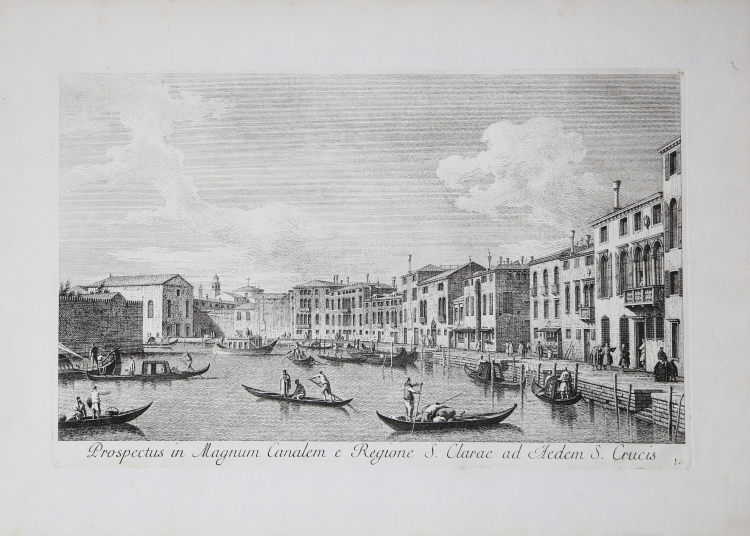




| Reference: | S51171 |
| Author | Antonio Visentini |
| Year: | 1742 |
| Zone: | Venice |
| Printed: | Venice |
| Measures: | 425 x 270 mm |



| Reference: | S51171 |
| Author | Antonio Visentini |
| Year: | 1742 |
| Zone: | Venice |
| Printed: | Venice |
| Measures: | 425 x 270 mm |
Magnifica veduta tratta Da Urbis Venetiarum Prospectus Celebriores, ex Antonii Canal Tabulis XXXVIII. Aere expressi ab Antonio Visentini, serie pubblicata nel 1742 in prima edizione completa comprensiva di trentotto vedute divise in tre parti e numerate rispettivamente I-XIV, 1-12, I-XII.
Bellissima prova nel I stato su 4, prima della comparsa del titolo bilingue e del cambio della numerazione, su carta vergellata coeva, in perfetto stato di conservazione.
Visentini fu uno dei più noti architetti della Venezia del tempo, ma la sua opera testimonia in modo esemplare come l’architettura si esprimesse allora ben oltre l’aspetto costruttivo. Fu piuttosto un professionista del disegno: pittore, incisore e grafico, autore di scritti sull’architettura e la prospettiva, infine insegnante per queste materie presso la pubblica Accademia di pittura scultura e architettura di Venezia. Le notizie che si possiedono sono principalmente legate alla sua opera di incisore e ai rapporti con Joseph Smith (morto nel 1770), console britannico tra il 1744 e il 1760 ma residente a Venezia fin dai primi anni del secolo, il quale – imprenditore, collezionista, intermediario d’arte e personalità di riferimento per gli artisti italiani operanti all’estero e per gli stranieri che toccavano la città lagunare – fu il suo principale committente e sembra aver indirizzato sensibilmente i suoi interessi.
Sul finire degli anni Venti del XVIII secolo, fu impegnato proprio da Smith nell’esecuzione di acqueforti derivate da dipinti di Canaletto: il Prospectus Magni Canalis Venetiarum, pubblicato solo nel 1735, era in buona parte concluso già nel 1730. La raccolta fu ampliata nel 1742 (Urbis Venetiarum prospectus celebriores) con vedute di campi e chiese tratte da dipinti di Canaletto e altri.
|
Antonio Visentini (21 November 1688 – 26 June 1782) was an Italian architectural designer, painter and engraver, known for his architectural fantasies and capricci, the author of treatises on perspective and a professor at the Venetian Academy. Born in Venice, Visentini was a pupil of the widely travelled Baroque painter Giovanni Antonio Pellegrini,[1] who had painted some decors in English country houses at the beginning of the 18th century. Visentini is best known today as the engraver for Canaletto's first great series of Venetian vedute published under the title Urbis Venetiarum Prospectus Celebriores ex Antonii Canal,[2] organised by British resident Joseph (Consul) Smith (1682–1770). The series was begun around 1728 and by the time it was completed in 1735, thirty-eight etchings and engravings had been printed.
On the Grand Canal, Visentini was commissioned to redesign the façade of the residence of Consul Smith, the Palazzo Balbi. He collaborated with Francesco Zuccarelli on capriccios based on English Palladian villas, again for Consul Smith;[3] some have passed with Smith's collection to the British Royal Collection. In Vicenza, Visentini painted frescoes at the Villa Valmarana, for which Gian Domenico Tiepolo painted the figures. In the 1760s the English architect James Wyatt studied with him as an architectural draughtsman and painter.
Visentini's work, the Osservazioni,[4] published in Venice in 1771, was intended as a complement and an extension of a treatise by Teofilo Gallacini (1564–1641), which concerned itself with the errors of Mannerist and early Baroque architecture.[5] Visentini's engravings in the Osservazioni illustrate his proposed modifications correcting Baroque architectural details.
Visentini taught at the Accademia di Belle Arti in Venice from 1772–78, and he died in Venice in 1782.
|
|
Antonio Visentini (21 November 1688 – 26 June 1782) was an Italian architectural designer, painter and engraver, known for his architectural fantasies and capricci, the author of treatises on perspective and a professor at the Venetian Academy. Born in Venice, Visentini was a pupil of the widely travelled Baroque painter Giovanni Antonio Pellegrini,[1] who had painted some decors in English country houses at the beginning of the 18th century. Visentini is best known today as the engraver for Canaletto's first great series of Venetian vedute published under the title Urbis Venetiarum Prospectus Celebriores ex Antonii Canal,[2] organised by British resident Joseph (Consul) Smith (1682–1770). The series was begun around 1728 and by the time it was completed in 1735, thirty-eight etchings and engravings had been printed.
On the Grand Canal, Visentini was commissioned to redesign the façade of the residence of Consul Smith, the Palazzo Balbi. He collaborated with Francesco Zuccarelli on capriccios based on English Palladian villas, again for Consul Smith;[3] some have passed with Smith's collection to the British Royal Collection. In Vicenza, Visentini painted frescoes at the Villa Valmarana, for which Gian Domenico Tiepolo painted the figures. In the 1760s the English architect James Wyatt studied with him as an architectural draughtsman and painter.
Visentini's work, the Osservazioni,[4] published in Venice in 1771, was intended as a complement and an extension of a treatise by Teofilo Gallacini (1564–1641), which concerned itself with the errors of Mannerist and early Baroque architecture.[5] Visentini's engravings in the Osservazioni illustrate his proposed modifications correcting Baroque architectural details.
Visentini taught at the Accademia di Belle Arti in Venice from 1772–78, and he died in Venice in 1782.
|